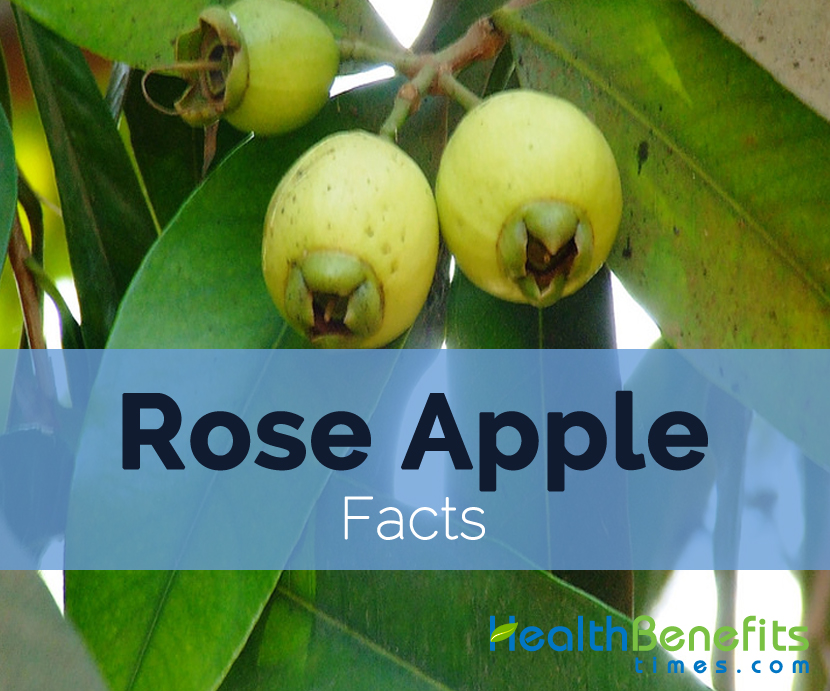 A Rose Apple is neither an apple nor a rose. It belongs to the same family of plums, apricots, peaches, cherries, raspberries, pears and almonds. It is a sensitive fruit which get bruises easily. It does better in wet, warm and humid areas with adequate rainfall. The tree bears a fruit about 2 kg after the growth of four years. This fruit is rich in polyphenols, potassium, vitamin C and dietary fiber.
A Rose Apple is neither an apple nor a rose. It belongs to the same family of plums, apricots, peaches, cherries, raspberries, pears and almonds. It is a sensitive fruit which get bruises easily. It does better in wet, warm and humid areas with adequate rainfall. The tree bears a fruit about 2 kg after the growth of four years. This fruit is rich in polyphenols, potassium, vitamin C and dietary fiber.
| Name | Rose Apple |
|---|---|
| Scientific Name | Syzygium aqueum |
| Native | East Indies and Malaya, also cultivated in Ceylon, the Pacific Islands, India and former Indochina. |
| Common/English Name | Bell Fruit, Watery Rose Apple, Water Cherry, Bell Apple, Water Apple |
| Name in Other Languages | Brazil: Jambeiro Aguado, Jambo Portuguese: D’agua Chinese: Shui Lian Wu; Dominican Republic (Spanish): Cajuilito Solimán; Dutch: Djamboe Aer; French: Jambosier D’eau, Pomme D’eau; German: Wasserjambuse, Wachsjambuse; Indonesia: Aceh: Jambi Raya, Jambi Iye; Bali: Jambu Er, Njamu Er; Batak: Jambu Erang, Jambu Aek, Besemah: Jambu Ayik Bimba: Jambu Jene, Bugis: Jambu Saiom, Jambu Salo; Boeol, Sulawesi, Manado: Takaw; Ceram, Moluccas, Ambon: Kepet, O’uno; Kalimantan, Dyak: Kubal; Gajo: Jambu Airjemerl; G orontalo: Omuto, Upo; Halmaheira: Yarem, Rowane; Jambi: Jambu Pingping , Java: Jambu Air, Jambu Uwer, Lampong: Jambu Air, Jambu Kelinga; Lingga: Jambu Bertih; Madurese: Jambhu Wir; Makassar: Jambu Jene; Malay, Bengkoelen: Jambu Keling; Manado: Gora; Minangkabau: Jambu Aye; Nias: Samba; Oelias: Rutu Putio, Jambu Waelo; Papua: Purori, Ansahmoh,; Sangir: Compose; Sawoe: Wo Luba Kume; Singkep: Jambu Aer; Serawaj: Jambu Ayak; Solor: Bluwo, Bluwa; Sulawesi, Moluccas: Kebes, Kouoa; Sundanese: Jambu Air; Ternate: Gora Yadi ; Tidore: Yadi; Toraja: Jambu, Wua Usa; Japanese: Mizu Renbu; Malaysia: Jambu Chili, Jambu Ayer; Papua New Guinea: Lal Lau; Philippines (Bisaya): Tambis; Spanish: Manzana De Agua, Perita Costena; Suriname: Pommerak; Thai: Machomphu-Pa, Chom Pu Pa |
| Plant Growth Habit | Tropical, evergreen, low |
| Growing Climate | Warm and humid climates with adequate rainfall |
| Soil | Well-drained |
| Plant Size | 3–10 m |
| Bark | Flaky brown |
| Branchlets | Wide spreading |
| Stem | 30 cm |
| Leaf | Narrow and glossy |
| Edible parts of the plants | Fruits: consumed as fruit salad or made pickle Leaves: used to wrap fermented sticky rice |
| Flowering Season | Midsummer (from June- August) |
| Flower | Greenish-white or creamy-white, Width: 2 to 4 in (5-10 cm), Diameter: 7.5-10 cm |
| Fruit shape & size | Bell-shaped, length: 5–8 cm |
| Fruit color | Pink-red |
| Flesh color | White |
| Fruit peel | Thin with smooth texture |
| Flavor/aroma | Not tart, simply aromatic |
| Fruit Taste | Mild sweet |
| Seed | 1 or 2, grey in color |
| Varieties/Types | Java Rose Apple, Malay Rose Apple, Jambu, Water Rose Apple |
| Fruit Season | Early winter to Late fall |
| Major Nutritions | Vitamin C (Ascorbic acid)22.3 mg (24.78%) Vitamin B3 (Niacin) 0.8 mg (5.00%) Carbohydrate 5.7 g (4.38%) Total dietary Fiber 1.5 g (3.95%) Calcium, Ca 29 mg (2.90%) Potassium, K 123 mg (2.62%) Vitamin A 17 µg (2.43%) Vitamin B2 (Riboflavin) 0.03 mg (2.31%) Copper, Cu 0.016 mg (1.78%) Vitamin B1 (Thiamin) 0.02 mg (1.67%) Manganese, Mn 0.029 mg (1.26%) Protein 0.6 g (1.20%) Magnesium, Mg 5 mg (1.19%) Phosphorus, P 8 mg (1.14%) Iron, Fe 0.07 mg (0.88%) |
| Calories in 1cup (100 g) | 25 Kcal. |
| Health Benefits |
|
| Traditional uses |
|
| Precautions |
|
| How to Eat |
|
| Other Facts |
|

